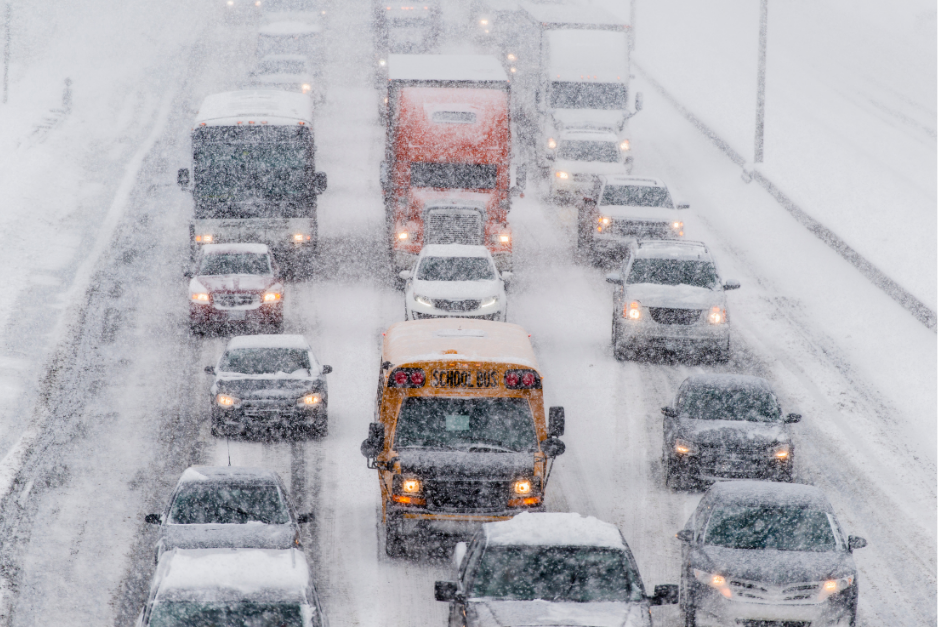Earlier this month, drivers stuck on I-95 in Virginia experienced the worst-case scenario for winter driving. Inclement weather conditions with snow and ice caused slippery roads and low visibility resulting in numerous accidents involving cars and trucks that brought traffic to a standstill and shut down a stretch of one of America’s busiest highways. The conditions left many stranded in their cars for more than 24 hours with little food, water or heat.
As safety professionals, this event caused us at TSS to immediately consider how motorists can avoid the worst of winter.
Whether it’s snow, sleet or ice, winter weather can cause extremely dangerous road conditions. In 2019, there were 440 fatal crashes, and an estimated 33,000 injury crashes that occurred during inclement weather events.
Prepare for the Worst
While we can’t control the weather, we can prepare our vehicles and ourselves:
- Start by getting your vehicle checked. Both your tires and the car battery work overtime during the winter months.
- Inspect your tires for pressure, tread and age. It is recommended that you get new tires at least every six years. In snowy areas plan on having winter tires installed or purchasing tire chains. Before buying new tires, visit NHTSA’s Tires page to review tire safety ratings. The Uniform Tire Quality Grading System (UTQGS) lets you compare tire treadwear, traction performance, and temperature resistance.
- When the temperature drops, so does battery power. In cold weather, gasoline and diesel engines take more battery power to start, and electric and hybrid-electric vehicles’ driving range can be reduced. Have a mechanic check your battery, charging system, belts, and for any other needed repairs or replacements.
- Make sure your windshield wipers are working properly and fill up with good quality wiper fluid.
- Be familiar with your car’s safety features.
- Stock your car’s emergency preparedness kit. Emergency kits typically include:
- Battery booster cables
- Ice scraper and brush
- Portable shovel
- Flashlight and batteries
- Roadside emergency triangle or reflectors
- basic first-aid kit
- Cell phone charger.
- Hat, gloves, blanket, rain poncho, wipes and rags and an extra pair of boots if possible.
- Bottled water, granola bars and other easy to transport snacks that aren’t perishable.
- Plan ahead. Keep in mind inclement weather is going to slow you down. Plan your trips accordingly and give yourself enough time to travel. Check the weather forecast before you leave, fill up on gas and make sure your phone is charged (but please don’t use it while you are driving.) Let others know where you’re going or at least when to expect you. If you know a storm is coming, consider postponing your trip.
- Buckle up. Especially if you have small children, check to make sure that you are still able to properly buckle them into their car seats when they are wearing winter layers. Bring a blanket to place on them after they are properly installed.
- Clean your car’s external camera lenses and side view mirrors so you’ll be able to see what’s around you. Remove dirt, ice and snow from sensors to allow the assistive-driving features like automatic emergency braking to work. Also clean the snow off the vehicle to keep drivers from being hit by piles of snow and ice.
- Allow your vehicle to fully warm up and those windows to defrost! Visibility is so beyond important, for obvious reasons.
- Drive slowly and increase your following distance. Driving too closely to snowplows can be particularly hazardous as they frequently make unexpected turns and stops.
- If you are stopped or stalled, stay with your car and make it visible by putting bright markers on the antenna or windows or use the emergency triangle. Be mindful of carbon monoxide poisoning. Make sure your exhaust pipe is clear of any snow and run your car only sporadically — just long enough to stay warm. Don’t run your car for long periods of time with the windows up or in an enclosed space.
While events like the shutdown of I-95 this week are rare and difficult to predict or prevent, preparation may keep you safe and a little more comfortable while you are dealing with your own winter driving challenges.

